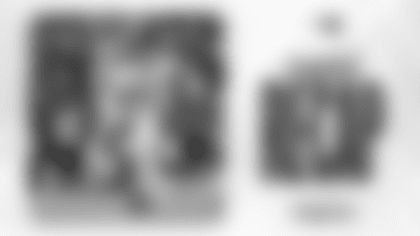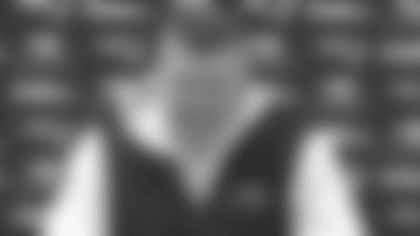Q: Jakob Johnson had a great block on Matt Milano to free up Sony Michel in the fourth quarter. How did that play show his development as a run blocker?
BB: I think that's a really good point you make there. There's a point in time that he definitely wouldn't have made that block and made that adjustment to it. But through experience and coaching and practice repetition and so forth, he's gotten a lot better at a lot of those things, not only the fit on the block, the technique and contact and all that. James Develin's really worked hard with him. They've spent a lot of time on the sled, and so much of blocking is body position and balance, and being able to deliver a blow on the move and still be able to maintain your balance to sustain it after contact. So those are very important fundamentals, especially at that position. He's worked hard to improve them.
Q: What do you tell a player on the sideline after being penalized for a hit like Jonathan Jones' on Josh Allen?
BB: I think when a player – when there isn't really much you can tell them to do differently, then I think you don't tell them anything. I mean, Allen's a big runner, he's a strong guy, he's hard to tackle. He certainly broke several tackles against us. Jon turned when he hit him, he didn't lead with his head, he didn't have that posture. So again, I think Al Riveron talked about the play yesterday and that's what we go by. So we'll coach it based on what Al's guidelines or commentary was on the play.
Q: What's your reaction to Sean McDermott's comment on Jones' hit and others who have spoken out about the hit, and your view on Jones' aggression on the field?
BB: Well, I think I just answered that question. Ultimately, the decision rests with Al Riveron, the game officials and the NFL office on that play. So it doesn't really matter what you think or what I think or what anybody else thinks, they're the ones who are officiating the play and we'll coach it within the rules as the rules are interpreted.
Q: Do you think Jonathan Jones is a player that has any intent to injure a player and plays near the edge of the envelope frequently?
BB: No.
Q: What have you noticed from John Simon over the last year and how he's adapted to his new role this season?
BB: Not sure about the new role this year, I don't really know what you're referring to there. Look, John's done a great job for us. He's a very instinctive player, he's got excellent playing strength, a great motor. He does a good job of finding the ball and diagnosing plays, be they runs, passes or plays that guys on the end of the line of scrimmage have to handle, misdirection plays, screens, things like that. So he does a great job of those things, and he did that for us last year and he's done it this year. That's what his role is and he does a great job of it.
Q: What did you see from your offense that allowed two big runs to happen on an important fourth quarter offensive drive?
BB: Well, we had a counter play which came back and hit on the weak side of the defense, and then I believe we cut back a lead play kind of similar to the first play of the game, if I remember that correctly. But in the end, I think when we were able to get a hat-on-a-hat, get solid contact on all the defenders, then we were able to make yardage, and when we weren't, then we didn't have that much success. So those plays were plays where we were able to do that. As I said, the one play was a counter play, the other play was a wham block, and that was the one we bounced outside. So the first one was the counter that we came back to the weak side of the defense. [The first play] came back to the weak side of the defense, and they had everybody down after we shifted the tight end over. They came down to that side, and so we head back weak side, and then the second play was a wham play that bounced outside and Julian made a good crack block on the safety there, and we were able to bounce it outside into some space and, whatever it was, pick up seven or eight yards. But, in the end on the running game, had the lead play early in the game, the cutback, when we were able to get a hat-on-a-hat and get the runner started, then Sony [Michel] was able to have some solid plays, but it was kind of some good gains or not much, and when we missed guys or they stunted or something happened where we weren't able to really get the play started, then we didn't have much. So it was a little bit of hit-and-miss in that area.
Q: Matthew Slater pointed out the unsportsmanlike conduct penalty he had in the fourth quarter and said he wanted to take a closer look at that. What's your view on those calls, is that something the officials are tighter on this year?
BB: Yes, definitely tighter on it. No question about that. Yeah, he's had a couple of tough calls on that. Yesterday the Bills doubled him and put two guys out there on him a lot, which he's seen that his whole career. He's seen plenty of that. There isn't really a great look at it on the film. It's kind of hard to see, but it looks like he's running down the sideline and he's trying to get back in bounds and the defender is kind of right on the sideline. I'm not sure if he's in the white or not in the white. It's very close, and they're kind of pushing each other and I think Matt's intent is to really get back into the field, and the defender is kind of pushing him a little bit wider. So I'm not really sure what the – it's a very close call in my opinion. So we've just got to try and fight to get back in there a little bit harder, but I think that's what Matt was trying to do, and it's a close call. So yeah, to your point, they're calling them closer and if that's the way they're going to call them, we're going to have to adjust our angle to return back there a little bit more. But as you know, the return team is not allowed to block in the white, so once they block the gunner out of bounds, then they have to wait for him to get back onto the field of play, and so it's obviously – look, those guys, they're running down the field full-speed. They're great athletes trying to match-up with another great athlete. They're not looking down at their feet to try and see are they in the white or are they not in the white. It's just a little bit of a feel, and instinctive and experience thing, but it's a close call. It's a fine line there, but as you said, they call them, so we've got to – there's going to be some close calls in the games that are going to go against us, and there'll probably be some close calls in the games that'll go in our favor. And however it is, we've just got to take it for what it is and play through it.
Q: Do you practice blocking punts like J.C. Jackson did, or is it something you have to have a feel for in the game and your intuition leads you to the right spot?
BB: No, it's 100% the former. We practice that every week. Blocking a punt's a drill that I've done every year I've been in coaching for 45 years. Every week we practice it. All of the guys on the punt return team practice it because you never know which guy is going to come free. You might think they're going to block it a certain way, but the guy makes a mistake. So we start those back in the spring and go through training camp and we have our fundamental rules about what the aiming point is depending on where you're located on the rush and where your aiming point is. That, of course, varies from team-to-team based on the punter's walk-off and which foot he punts with, and so forth. But once you identify where the block point is, then you take the proper aiming point there so that your aiming point and your path intersect the ball, but doesn't intersect the kicker's path. So you can't run right at the kicker and miss the ball and run into the kicker. You run at a point that enables you to miss the kicker, whether you get the ball or not, so that you don't have the roughing the kicker penalty that you're referring to. So it's absolutely something we practice, and those are the kind of things, as I said, from week-to-week are a little bit different because each punter's launch point is a little bit different. It could be anywhere from nine yards, nine-and-a-half yards, to ten, maybe ten-and-a-half on a guy with a shorter – either one less step, or a little shorter stride, but it's in that range somewhere, generally speaking. Once you get to the spot, then you have to have the proper technique of hitting the ball with your hands as it comes off his foot, and then reacting after the punt's blocked. Making the decision there, if it crossed the line of scrimmage or not, or whether to fall on it or pick it up and so forth and so on. But yeah, it's something we absolutely work on every week, it was a great play by J.C., and Matt Slater was really close on another one. Similar type of play, he was just coming from one spot further in. We almost had that one. That one, I think it looked like Corey [Bojorquez] might have seen him coming and kind of, I think that's the one he hooked it out-of-bounds. It only went 20 yards or something like that. So if he had punted that one with his normal stride, Matt might have had that one. But yeah, it's something we absolutely work on every week, 100%.
Q: How do you make the determination or balance scheming to keep a quarterback inside the pocket versus trying to move them off their spot?
BB: I think you pretty much answered it right there, that you want to have some type of a plan that does keep the offense off-balance. Quarterbacks that are athletic like Allen, they've seen a lot of this before. They've seen players spy them and they've seen rushes where the ends go up the field to contain them. So they've seen different things like that, and I think if you just do the same thing all the time, then it's pretty easy for them to figure out what you have, and what you have covered, and kind of where you're vulnerable and they can do a good job attacking that. I think if you mix it up on them, then they have to make a little bit of a decision between reading the coverage and reading the rush, and figuring it all out instead of just knowing what the rush is going to be and just reading the coverage, and if the coverage is good then they know how you're trying to rush him and they don't have to identify it, they can kind of anticipate what it's going to be. So like any good player, you want to keep them off-balance and not do the same thing every time, but you have to do something that you can execute. That's really the key, is whatever you're trying to do, how good you can do it.
Q: How has Adam Butler developed this year to complement his quickness with improved strength?
BB: Adam's a very intelligent player and he has very good football instincts. So you can give him a lot of information and he kind of knows when to apply it and when not to apply it. So his ability to do the right thing at the right time based on a call, or based on the way that the line blocks, or kind of the protections they use, things like that in the pass rush, even in the running game; he does a good job of recognizing those things quickly and making good decisions, which is really hard to do when you're in-line like that. You have so many people close, right on top of you, and especially when he plays on the nose. A lot of times there's three guys that can block him, center and either guard, especially if we're in an odd front. So it's a tough position to play, but he does an excellent job of using his quickness, using his length and making really good football decisions based on what happens in a very short amount of time. I mean, you can coach those things, and we do, but to make those decisions as quickly as he makes them, and as instinctively as he does it is pretty good. It's pretty unique. All players get better with coaching, all players get better with experience, but his growth in three years now has really been impressive. His ability to adapt and adjust depending on who he's working with on the defensive line. So again, we have a number of different players in there between linebackers and defensive lineman. Guys like [Michael] Bennett and [Deatrich] Wise, who are more pass-rusher types, and Danny [Shelton] and Lawrence [Guy], who can be a little more in the run-player category. So his ability to interact with them and play off of them versus playing off of guys like [Jamie] Collins and [Kyle] Van Noy and [Dont'a] Hightower and [John] Simon, Shilique [Calhoun]. It's a little bit different. He does a good job with all of it. So, very instinctive player. He's really absorbed a lot of information since he came here the last two-and-a-half years.
Q: As the only guy with his hand down at times, does that make it more difficult to play off of those guys?
BB: Well as I said, it's a little bit tougher for him because he's got three guys that can block him. A lot of times, defensive linemen line up and they're pretty sure it's going to be one guy that's going to block him, and maybe it's one of two. You know, if you're in a gap it's one of two guys and you can usually tell which guy it is, but maybe not always. But yeah, when you're on the nose and we're in as much odd front as we're in, again, it can be any one of three guys. On run plays, pass plays, they can pull. There are different types of protections they can use where the center can block or they can slide one way or the other, or sometimes it's kind of a half a slide where the center sort of puts his hand on the nose, but the guards really have him. So again, there are a lot of little things like that that can come up in there, so yeah, it is. When you're the only guy down and other people are moving around, it's a lot less predictable than if you line up the front in an over or under and you know where all of the defensive linemen are and you can kind of anticipate that the line's going to slide to where most of your guys are. Yeah, it's definitely harder in some of the situations he's in where everybody's on their feet and they're moving around. A lot of the recognition doesn't come until post-snap.













































